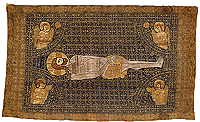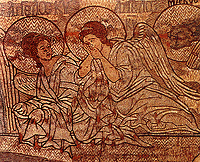 |
|
 |
The minor arts
 ne category of the minor arts, which flourished greatly during the Palaiologan era, was
gold embroidery,
ne category of the minor arts, which flourished greatly during the Palaiologan era, was
gold embroidery,
 although there had been luxury fabrics in previous periods as well, as we are informed by countless written sources. These fabrics, which are mentioned as chrysokenteta ("gold embroidered"), syrmateina ("embroidered with gold wire"), or chrysoklabarika, belonged exclusively to the wardrobe of officials of the court and dignitaries of the Church.
although there had been luxury fabrics in previous periods as well, as we are informed by countless written sources. These fabrics, which are mentioned as chrysokenteta ("gold embroidered"), syrmateina ("embroidered with gold wire"), or chrysoklabarika, belonged exclusively to the wardrobe of officials of the court and dignitaries of the Church.
The fact that, in the palace, there was a special vestiary, the Pentapyrgion ("five towers"), the windows of which were left open on special occasions to allow the local people as well as foreigners to admire the costly fabrics that were kept there, is indicative of the esteem in which they were held by the Byzantines. According to laws of the state, luxurious fabrics were as valuable as gold and their export was prohibited, while special regulations governed their production and sale.
The gold embroidered fabrics preserved to this day are mostly pieces intended for ecclesiastical use.
 Sacerdotal vestments and liturgical cloths such as the
epitaphios
and the
aer,
which are used during the Divine Liturgy, survive today in monasteries of the Balkans and in Western European collections. The oldest of these, dating from the 12th century, are preserved in the cathedral of Halberstadt in Germany. From the 14th century on, we see an increasing number of gold embroidered fabrics. The vestment known as the "Dalmatic of Charles" in the Vatican is a typical piece. It is a particularly sumptuous patriarchal
sakkos,
which dates from the end of the 14th century. The
sakkos of the Patriarch of Russia, Photios (1408-1432), a gift from the Byzantine Emperor
John VIII Palaiologos, which
dates from 1416-18, is of particular interest. The epitaphioi which survive from the Palaiologan period constitute remarkable works of art. Gifts of emperors or members of the aristocracy to monasteries and churches, they reflect the refined taste and the affluence of the higher social class. The epitaphios of the church of St. Kliment (or the Virgin Peribleptos) in Ohrid (end of the 3th century), a gift from the Emperor
Andronikos II Palaiologos, which was unfortunately lost after the war, the epitaphios of the monastery of Vatopedi at Mount Athos, offered by
John VI Kantakouzenos
around 1354, and the epitaphios of Thessalonike (beginning of the 14th century) constitute outstanding pieces of artwork. The latter, in particular, is considered to be one of the masterpieces of Palaiologan art, and was much copied by later epitaphioi. Among these, worth mentioning is the epitaphios offered by Nicholas Eudaimojoannes, a well-known nobleman of Monemvasia, which dates from 1407 and is today preserved in the Victoria and Albert Museum in London. Sacerdotal vestments and liturgical cloths such as the
epitaphios
and the
aer,
which are used during the Divine Liturgy, survive today in monasteries of the Balkans and in Western European collections. The oldest of these, dating from the 12th century, are preserved in the cathedral of Halberstadt in Germany. From the 14th century on, we see an increasing number of gold embroidered fabrics. The vestment known as the "Dalmatic of Charles" in the Vatican is a typical piece. It is a particularly sumptuous patriarchal
sakkos,
which dates from the end of the 14th century. The
sakkos of the Patriarch of Russia, Photios (1408-1432), a gift from the Byzantine Emperor
John VIII Palaiologos, which
dates from 1416-18, is of particular interest. The epitaphioi which survive from the Palaiologan period constitute remarkable works of art. Gifts of emperors or members of the aristocracy to monasteries and churches, they reflect the refined taste and the affluence of the higher social class. The epitaphios of the church of St. Kliment (or the Virgin Peribleptos) in Ohrid (end of the 3th century), a gift from the Emperor
Andronikos II Palaiologos, which was unfortunately lost after the war, the epitaphios of the monastery of Vatopedi at Mount Athos, offered by
John VI Kantakouzenos
around 1354, and the epitaphios of Thessalonike (beginning of the 14th century) constitute outstanding pieces of artwork. The latter, in particular, is considered to be one of the masterpieces of Palaiologan art, and was much copied by later epitaphioi. Among these, worth mentioning is the epitaphios offered by Nicholas Eudaimojoannes, a well-known nobleman of Monemvasia, which dates from 1407 and is today preserved in the Victoria and Albert Museum in London.
From this period on, the surviving items are many and represent an art that will continue to flourish in Constantinople even after the Turkish conquest, and will be disseminated in the other countries of the Balkans and in Russia as well. Indicative of the evolution of this art from the 17th century on is the celebrity attained by the creators of these works, such as Despoineta, a famous embroideress of Constantinople.
|